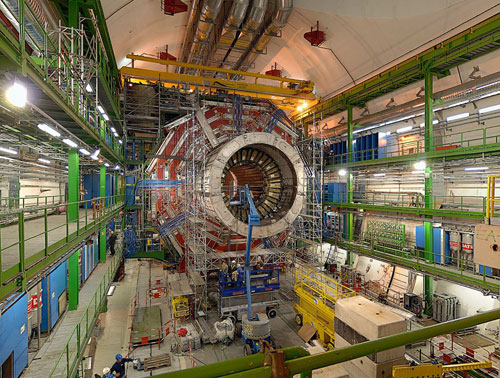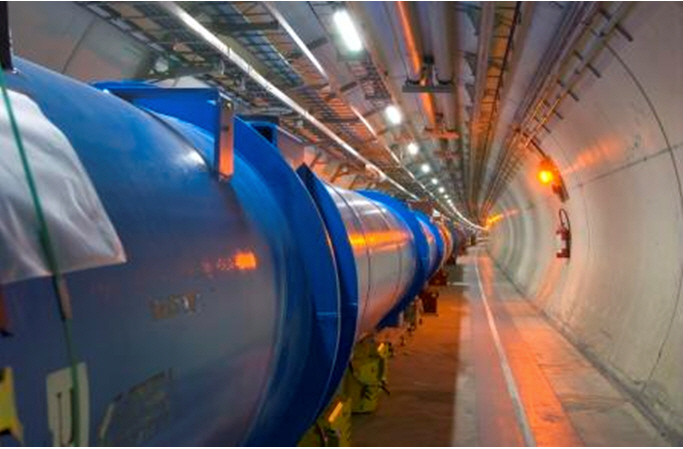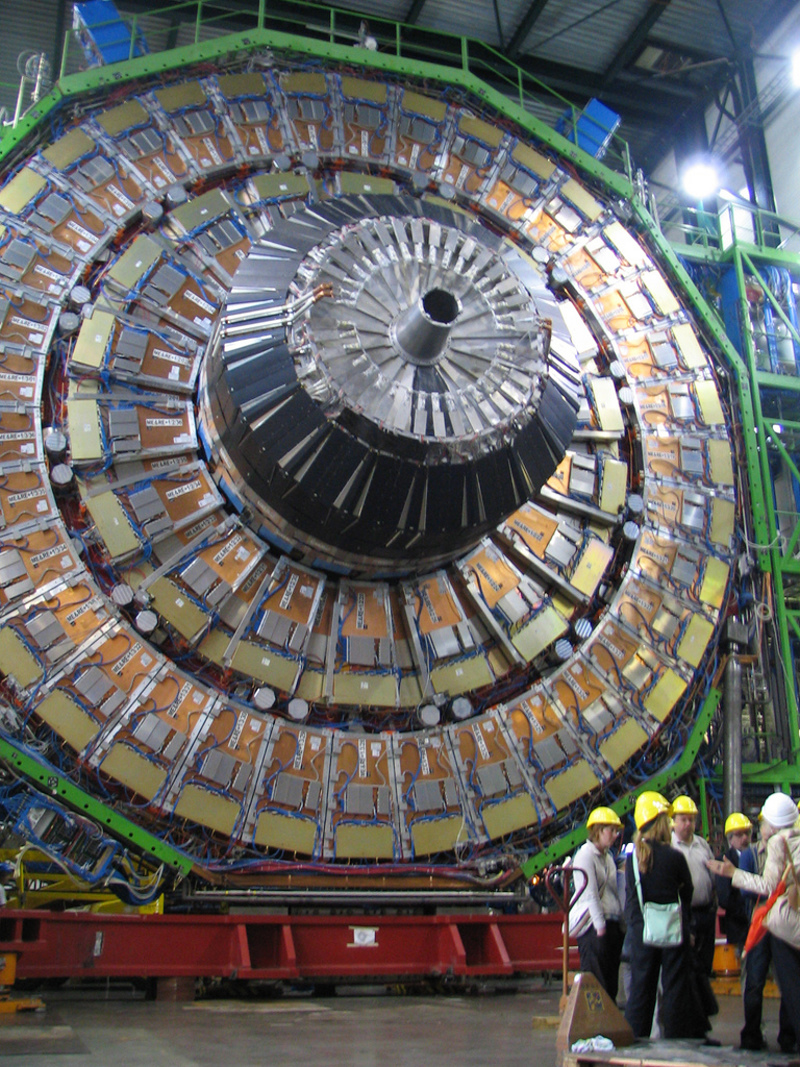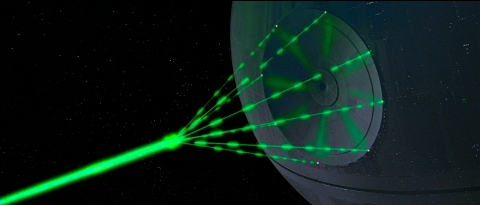In the eastern
regions
of France, near Lyon, flanked by virgin pine
forests, streams, lakes and
fir clad mountain ridges, bordering on
Switzerland, lays the CERN (Conseil
Européen pour la Recherche Nucléaire) facility
which houses
over 6,300 scientists working feverishly to
bring online the next generation
in basic particle super-colliders. This massive
Hadron collider is a magnetic
ring 27 kilometers in circumference: Ultimately,
it will collide beams
of protons at an energy of 14 TeV. Additionally,
beams of lead nuclei will
be also accelerated, colliding together with an
energy of 1150 TeV. The
LHC will be the most powerful particle
accelerator in the world.
The main purpose
of this facility is to produce antimatter
and black holes. A terrorist would need only
half of a gram of antimatter
to be equally destructive as the Hiroshima
bomb. If CERN’s antimatter
factory were to blow up today it would only
affect the regions bordering
France and Switzerland. But if CERN were to
produce just one stable black
hole , it could destroy the world.
Surprisingly, the United States
of America, through the National Science
Foundation and the Department
of Energy, will be funding over $1 Billion
Dollars towards this French
experiment into creating potentially devastating
black holes.
These black
holes, the densest matter in the universe,
will plummet to the very core of the earth,
then, slowly at first, growing
one particle, one quark at a time, but at an
ever accelerating rate.
Scientists have estimated that a stable black
hole at the center of the
earth could consume not only France but the
whole planet in the very short
time span of between 4 minutes and 30 seconds
and 7 minutes.
That age-old
question: Will our planet disappear in
the twinkling of an eye? - Now becomes a
probability if and when the CERN
facility is allowed to go on-line in 2008.
IMPORTANT
NOTE: On Tuesday, March 27, 2007, there
was a devastating explosion deep in the tunnel
at the CERN particle accelerator
complex that actually blew a 20 ton magnet right
off its mountings. The
explosion filled the tunnel with helium and
forced a mass evacuation of
the facility.
While the
facility was supposed to go online during
the summer of 2007, the new startup is
tentatively summer of 2008 after
17 miles of magnets have been repaired or
replaced. This explosion, to
those of us who count ourselves among the
worried masses, appears to be
an ominous foreshadowing of what could
eventually become the Second-Coming
of the Big Bang...
Even Dr. Lyn
Evans, who heads the accelerator project
at CERN, said the explosion had been potentially
very dangerous. "There
was a hell of a bang, the tunnel housing the
machine filled with helium
and dust and we had to call in the fire brigade
to evacuate the place,"
he said. "The people working on the test were
frightened to death but they
were all in a safe place so no-one was hurt."
An investigation
by the researchers found that basic
math flaws had caused the explosion -- which
gives one pause in contemplating
how much faith can bestowed upon 6,000
scientists who can overlook basic
math mistakes. Not only was this mistake made in
the original design phase,
but it was also missed on four engineering
reviews carried out over a period
of four years. The director of Fermilab, Pier
Oddone, blithely wrote about
the disaster stating that they had caused "a
pratfall on the world stage".
A pratfall ? Should these Keystone-scientists be
entrusted with the fate
of the world in their hands?
CERN scientists
obviously talk of the scientific wonders
and benefits these experiments will bring.
Aurélien Barrau and Julien
Grain speaking on behalf of CERN say that these
"tiny black holes could
offer a richer view of physics than their better
known, more massive relations
… It should be stated … that these black holes
are not dangerous and do
not threaten to swallow up our already
much-abused planet." When it was
finally disclosed that this facility would
actually be producing, during
normal high-impact collider experiments, one
black hole each and every
second, numerous scientists cautioned that a
public risk-assessment by
non-affiliated scientists must be conducted for
the CERN facility but not
by the CERN scientists or the French government.
To this very day the French
have refused to make such an assessment of the
potential dangers that lay
ahead for all of humanity once the switch is
finally pulled.
In 2008, when
they fire up the Large Hadron Collider,
Global Warming and Osama bin Laden's al-Qaeda
network will suddenly become
the least of our earthly worries.
The French
defend their playing at God and this potential
black hole catastrophe by saying:
1.
Black holes have been
created by cosmic rays without incident;
therefore black holes are not
a danger to the planet earth.
Response
A. No instrumentation or observations
have ever detected the formation of black holes
in the atmosphere; It is
a completely unsubstantiated theory that was
fabricated solely to defend
the building of CERN. 1,600 hot-tub-size
cosmic-ray detectors positioned
over a vast area of nearly twelve hundred square
miles (the ground array
system for the Pierre Auger Cosmic Ray
Observatory) were installed in the
Pampa Amarilla in Argentina, located at the edge
of the town of Malargue,
in an effort to detect particle showers from
disintegrations of microscopic
black holes in the atmosphere. To-date this
experiment has detected numerous
cosmic-ray air showers, (the observatory is
presently measuring more than
500 air showers each and every day) but has
failed to detect any black
holes spawned by cosmic rays. Since this
controversial theory is the backbone
to the supposed safety of the CERN black hole
factory, startup should not
be allowed to occur under any circumstances
until the Auger Observatory
can prove that harmless atmospheric black holes
actually exist.
Response
B. Even if a black hole could be formed
by cosmic rays striking atmospheric particles,
it would be a glancing blow
at near the speed of light, causing the
resultant mass to careen off into
space at a velocity much greater than the escape
velocity of the earth
(11.2 km/s).
While, in
contrast, the CERN particles would be striking
each other as in a head-on collision, causing
the resultant black holes
to lose their momentum; making them unable to
reach escape velocity; causing
them to immediately free-fall, undetected, to
the center of the earth.
2. The black holes CERN
creates will not be stable. “Black hole
production does not present a conceivable
risk at the LHC due to the rapid decay of the
black hole through thermal
process”. They will be unstable and will
evaporate in a flash as predicted
by Stephen Hawking in 1975. The CERN facility
was built under the assumption
that Hawking radiation was a fact and that the
black holes they would automatically
create would be unstable and therefore not be
a threat to the human race
and the planet upon which we reside.
Response
A. No instrumentation or observations
have ever detected the Hawking radiation being
emitted from any black hole.
Kip S. Thorne, a professor of theoretical
physics at Caltech, who has been
working on evaporation with Hawking, says: “It’s
possible, we understand
quantum fields far less that what we believe and
it’s a mistake when we
think black holes evaporate. It is however true
that we should feel more
in ease if astronomers could effectively observe
clues of black holes evaporation”.
Response
B. Black holes by their very definition
are stable: Nothing escapes their
gravitational pull. And that includes
radiation.
Response
C. In Dublin Ireland on July 21 2004,
Stephen Hawking, at the age of 62, retracted his
original 1975 concept
whereby matter disappearing into black holes
traveled through the black
hole to a new parallel universe – just like on
Star Trek! After 30 years
of thinking about the paradox he created, that
violated the 1st Law of
Thermodynamics, Stephen Hawking now admits that
he was wrong about the
dynamics of black holes. Stephen Hawking went on
to say; “I’m sorry to
disappoint science fiction fans, but if
information is preserved, there
is no possibility of using black holes to travel
to other universes.”
Hawking’s original theory was more of a personal
view, a hunch, which was
not necessarily shared by the scientific
community or even demonstrated
by any cosmic observations. But CERN still
looks upon it as the Holy
Grail to this very day, even after Hawking
admitted that his theory was
wrong. Hawking radiation has always been a
purely theoretical manifestation.
There are many published papers by prominent
scientists who have always
asserted that such radiation does not exist.
CERN, by doggedly relying
on false science, could easily end up being the
mega-industrial accident
that wipes out the entire world.
How can such
cosmic arrogance be stopped? Obviously
reasoning will never work.
Where Stephen Hawking went so
terribly wrong…
Hawking, at the
age of 33, published his most famous
scientific paper in 1975 – that all black holes
were unstable and would
emit radiation. In effect, the black hole's
energy was slowly radiated
away until after a certain amount of time,
depending on its mass, it ceases
to exist – the black hole ‘evaporates’. He based
his theory on the 2nd
Law of Thermodynamics – that entropy affected
all matter in the universe
while at the same time it violated the 1st Law
of Thermodynamics. The paradox
lie in his argument that objects really
“disappeared” inside a black hole
and left no trace, while the 1st Law of
Thermodynamics says matter can
be transformed but never fully destroyed.
Hawking argued
by inference that the 1st Law was wrong
while the 2nd law was correct – an obvious
untenable paradox.
A colleague of
Stephen Hawking at Cambridge University,
Gary Gibbons, stated that "His style of doing
science is quite dramatic.
Hawking will propose a thesis and defend it to
the last, until it is overthrown
by better reasoning." For thirty years
Hawking defended a poorly
reasoned idea.
Stephen Hawking
thought that since the 2nd Law proved
that entropy existed in all previously observed
matter/energy exchanges
then black holes also must follow the 2nd
Law. What he did not consider
was that black holes are the singular exception
that proves the rule.
Black holes are natures only Perpetual Motion
Machines. They chew up matter
and energy transforming them into nature’s most
fundamental particles swirling
about in a quark-gluon plasma. They absorb
energy/matter but never release
energy/matter. When they have absorbed
everything within their gravitational
reach, they quietly wait in their black shroud
of invisibility for the
next passing star. And when there are no
more stars they still just
wait patiently as the eons pass.
Original Source: Misunderstood
Universe






